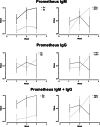Evaluation of three immunochromatographic tests for rapid detection of antibodies against SARS-CoV-2
- PMID: 32808111
- PMCID: PMC7431115
- DOI: 10.1007/s10096-020-04010-7
Evaluation of three immunochromatographic tests for rapid detection of antibodies against SARS-CoV-2
Abstract
Lateral flow immunoassays (LFIA) for rapid detection of specific antibodies (IgM and IgG) against SARS-CoV-2 in different human specimens have been developed in response to the pandemic. The aim of this study is to evaluate three immunocromathographic assays (Sienna®, Wondfo® and Prometheus®) for detection of antibodies against SARS-CoV-2 in serum samples, considering RT-qPCR as a reference. A total of 145 serum samples from 145 patients with clinical suspicion of COVID-19 were collected: all of the samples were tested with Sienna®, 117 with Wondfo® and 89 with Prometheus®. The overall results of sensitivity, specificity, positive predictive value and negative predictive value obtained were as follows: 64.4%, 75%, 85.5% and 47.8% with Sienna®; 45.2%, 81.8%, 80.5% and 47.4% with Wondfo® and 75.5%, 12.5%, 51.4% and 29.4% with Prometheus®. The accuracy of the test for Sienna®, Wondfo® and Prometheus® was 67.6%, 59% and 47.2%, with a prevalence of COVID-19 of 69.7%, 62.4% and 55.1% respectively. Sensitivity of the three tests (Sienna®, Wondfo® and Prometheus® respectively) along the three different stages was 36.6%, 18.8% and 68.6% in the early stage (first week); 81.3%, 74.1% and 90.9% in the intermediate stage (second week) and 100%, 83.3% and 100% in the late stage (third week). The results demonstrate that even though Prometheus® presented a high sensitivity, the specificity was notably lower than the other two tests. Sienna® showed the greatest contrast between sensitivity and specificity, achieving the best accuracy, followed by Wondfo®. The sensitivity of the three ICT assays was higher in late stages of the disease.
Keywords: COVID-19; Immunochromatographic strip assay; Lateral flow immunoassays; SARS-CoV-2; Serology.
Conflict of interest statement
The authors declare that they have no conflict of interest.
Figures
References
-
- Lu R, Zhao X, Li J, Niu P, Yang B, Wu H, Wang W, Song H, Huang B, Zhu N, Bi Y, Ma X, Zhan F, Wang L, Hu T, Zhou H, Hu Z, Zhou W, Zhao L, Chen J, Meng Y, Wang J, Lin Y, Yuan J, Xie Z, Ma J, Liu WJ, Wang D, Xu W, Holmes EC, Gao GF, Wu G, Chen W, Shi W, Tan W. Genomic characterisation and epidemiology of 2019 novel coronavirus: implications for virus origins and receptor binding. Lancet. 2020;395:565–574. doi: 10.1016/S0140-6736(20)30251-8. - DOI - PMC - PubMed
-
- Corman VM, Landt O, Kaiser M, Molenkamp R, Meijer A, Chu DK, Bleicker T, Brünink S, Schneider J, Schmidt ML, Mulders DG, Haagmans BL, van der Veer B, van den Brink S, Wijsman L, Goderski G, Romette JL, Ellis J, Zambon M, Peiris M, Goossens H, Reusken C, Koopmans MP, Drosten C. Detection of 2019 novel coronavirus (2019-nCoV) by real-time RT-PCR. Euro Surveill. 2020;25:1–8. - PMC - PubMed
Publication types
MeSH terms
Substances
LinkOut - more resources
Full Text Sources
Medical
Miscellaneous




